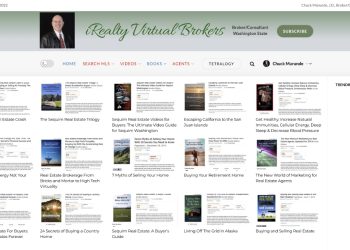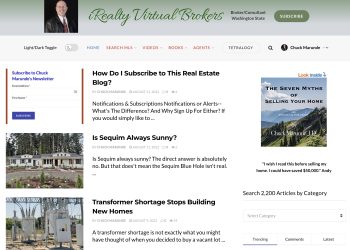Selling a home, buying a new one, and transitioning between the two can be an challenging process and nearly all of my retiree buyers make this kind of transition. To successfully navigate this journey, it’s important to understand the market dynamics in both markets, timing considerations, and financial implications. Knowing what to expect at each stage can significantly ease the transition, ensuring a smoother experience. Having an experienced listing agent on one end and an experienced buyer’s agent on the other end makes all the difference when it comes to reducing stress.
For sellers, pricing the home accurately, staging it effectively, and marketing it well are critical steps. Buyers, on the other hand, must focus on securing financing, unless they’re paying with cash, finding a property that suits their needs, and negotiating the best terms. Integrating these steps seamlessly requires careful planning and professional guidance. It goes without saying that a lot of things could go wrong, and this transition into retirement is far too important to mess up.
The transition phase is where many face the most stress. Packing, coordinating move dates, and handling the emotional aspects of leaving a familiar place while settling into a new one are all part of the process. Let’s face it, this is a time when you’ll feel there’s a lot of your plate, almost too much to handle. A strategic approach to managing these elements can greatly reduce the anxiety and make the move a positive step forward, and as a buyer’s agent I have a very strategic process that retirees have found very effective in handling all the details in handing the details on both their selling and buying ends as well as keeping the stress as low as possible. One key to managing stress is being proactive and knowing what to expect so you can plan ahead.
Preparing to Sell Your Home
There’s a lot to think about and do when you are listing and selling a home. I’m a buyer’s agent in Sequim, Washington, so you’ll be working with a listing agent wherever you are selling. Many of my buyer clients come from California, Colorado, Florida, Alaska, and 35 other states. Because so many sellers get stuck with unethical or incompetent listing agents in other states, I wrote a book to help you do your research on the best listing agent in your area as well as all the traps for the unwary seller that, in fact, catch many retirees again and again. Hence, my passion to write a book to help you navigate that process. You’ll find that book on Amazon, and it is titled The 7 Myths of Selling Your Home With 20 Secrets You Need to Know.
Setting the Right Price on The Selling End
Establishing a competitive listing price is essential. The house should be priced based on “true fair market value,” not what you need to buy your next home. Be careful about listing Realtors who “bid for listings,” as I’ve been calling it for years. This can happen when you interview 3 listing agents, and you list with the Realtor who gave you the highest price, but this is how many unethical Realtors get listings–by simply outbidding all the others. Then after a month your listing agent is calling up to tell you to lower the listing price based on feedback from other Realtors and other buyers who have seen the home. This can go on several times, and as a home seller you have no idea your listing agent knew this would happen, but it was all part of his or her scheme to guarantee they would get the listing and ultimately earn a sale after you came down multiple times on the price. Meanwhile, the honest Realtors who gave you realistic listing prices watch the whole affair from a distance knowing how your own listing agent stabbed you in the back from the beginning, and you’ll never know that with any certainty.
Of course, pricing too high can deter potential buyers, causing the house to sit on the market longer. On the other hand, pricing too low might result in leaving money on the table. One big caution I would share here, and something I have seen in every single market recession over my past 4 decades in real estate, is a very serious crisis for home sellers, and rather than give you a long detailed explanation, I’ll try to pack it into a single sentence. A home seller who lists with an inexperienced listing agent will often chase the price down as the market continues to decline in a recession. If the home had been priced realistically in the beginning, it could have sold, but because the listing agent keeps recommending a reduction in the listing price that is always behind the falling market, it’s always priced above the “true fair market value” at the time.
If you’re listing and selling a home in order to buy a home in your new destination, I strongly recommend you read my articles titled Sellers Chase The Market Down. It’s a detailed explanation of what happens to far too many good home sellers, and the article gives detailed real life examples.
Enhancing Curb Appeal
First impressions are vital when selling a house. Enhancing curb appeal ensures the property catches the eye of potential buyers. Simple steps such as maintaining the lawn, painting the front door, and planting flowers can make a significant difference.
Addressing minor repairs like broken fences, gutters, or chipped paint also helps. Clean, well-maintained exteriors suggest that the house is well-cared for, which can instill confidence in buyers. A visually pleasing and inviting exterior sets the tone for the entire viewing experience.
A lot of sellers won’t do it, but I would recommend you pay for a home inspector to come in and do a full report when you first list your home for sale. This gives you the ability to see what a buyer’s home inspector will discover, and you can repair it in advance to eliminate delays and potential problems when a sincere buyer comes along.
Staging for Potential Buyers
Staging the house effectively showcases its best features and creates a welcoming environment. Decluttering and removing personal items allow potential buyers to visualize themselves living in the space. Utilizing neutral colors and simple decor can make rooms feel larger and more appealing.
Proper lighting, fresh linens, and minor updates like new hardware on cabinets can also enhance the home’s appeal. Professional staging services or advice from an agent can provide additional insights. The goal is to make the house look attractive and ready for immediate occupancy, increasing its desirability.

Understanding the Home Buying Side
The home buying cycle involves several key steps, including evaluating personal needs and budget, and conducting thorough market research. Each step plays a critical role in the success of a property purchase. I’ve written many articles on the steps to buying a home in Sequim, Washington, giving retirees the strategy and specific steps involved, and guiding them with articles and videos, but of course, if I’m acting as their buyer’s agent, then they don’t have to figure everything out by themselves to avoid traps for the unwary.
Assessing Your Needs and Budget
Before diving into the home buying process, it is crucial to assess both your needs and your budget. Consider factors such as the size of the home, the number of bedrooms, and specific amenities. For quite a few years now, I’ve observed retirees downsize from the big houses that were so popular in the ’90’s, the 5,000 to 7,000 square foot gorgeous custom built homes. Retirees no longer need the space with all the kids out of the house, and they also have shed the “keep up with the Jones’s” phase that America went through from the ’70’s through the 90’s.
Finances play a significant role. Buyers should analyze their financial situation, including savings, income, and debts. It’s beneficial to get pre-approved for a mortgage to understand how much they can afford. A clear budget helps in preventing overspending and provides a realistic view of potential financial commitments.
Researching the Market
Research is vital in the home buying cycle. Potential buyers need to understand the local real estate market, including current trends and pricing. Examine market conditions to determine if it is a buyer’s market, where prices are more favorable for purchasers. Studying past and present market data can provide insights into future trends and help buyers make informed decisions.
Utilize various resources such as real estate websites, local listings, and professional advice. You’ll find the biggest and best resources to do your research on this blog, on my Youtube Channel, and perhaps the best gateway to all the resources I make available to my buyer clients is from what you might think of as a portal to Sequim Real Estate for Buyers at iRealty Virtual Brokers. You’ll see links to powerful resources as well as scheduling a telephone appointment with me, and getting access to my online courses for buyers (most are free), as well as the 9 real estate books I wrote for buyers going through this transition from selling a home to buying a home.
Navigating Financial Considerations

Understanding financial considerations is crucial for a seamless home selling and buying experience. Key aspects include assessing mortgage options, evaluating bridge financing, and considering cash offers. Most of my retiree buyers are paying in cash after selling a home elsewhere, and frankly retirees are not going to pay the high 7% mortgage rates we are seeing.
Transitioning Between Homes
Moving from one home to another involves careful planning and consideration. Key aspects include the timing of the move, finding temporary housing solutions, and managing periods when two housing commitments overlap. No one want to move twice, which they would have to do if they have to rent a home for a period of months before buying and moving into their final retirement home.
The Logistical Challenges of Moving
Moving involves several critical tasks that require precise planning and execution to ensure a smooth transition. It’s essential to focus on packing efficiently, hiring reliable movers, and preparing for unforeseen circumstances.
Packing and Organizing
Packing and organizing are among the most significant logistical challenges in moving. Sorting items into categories, such as essentials, donations, and disposals, can streamline the process. Use sturdy boxes, proper labeling, and inventory lists to keep track of belongings. Specialized packing supplies for fragile items and clear labeling help prevent damage and loss.
Creating a timeline for packing different rooms can make the task less overwhelming. Start with non-essential items and work towards daily necessities. Communication within the household about the packing plan ensures everyone contributes and stays informed.
Hiring Professional Movers
Professional movers can significantly ease the burden of moving. Researching and selecting a reputable moving company is crucial. Obtain multiple quotes, check reviews, and verify credentials. A well-chosen moving company will handle items with care, ensuring safe and efficient transport.
It is important to communicate clearly with movers regarding any special requirements or fragile items. Scheduling the move and coordinating logistics with the moving team helps avoid last-minute issues. Consider insurance options offered by the moving company for added protection.
Creating a Contingency Plan
A contingency plan is vital for addressing unexpected events during the move. This plan should cover potential delays, damaged items, or last-minute changes. Keeping some funds aside for emergencies can be beneficial. Communication is key in managing unforeseen problems effectively.
Preparing a list of alternative contacts, such as backup movers or temporary storage solutions, ensures quick problem-solving. Factor in potential risks, such as weather conditions or vehicle breakdowns, and devise strategies to mitigate them. A well-thought-out contingency plan ensures readiness for any eventuality.
Life After Moving
Adapting to a new location involves getting acquainted with the community and making the new house feel like home. This period can be both exciting and challenging as it includes integrating into a new neighborhood and adjusting to a different living space.
Settling into Your New Community
It’s important to take active steps to become part of the new neighborhood. Introducing oneself to neighbors, participating in local events, and joining community groups can provide a sense of belonging. Families may want to explore nearby parks and recreational areas to familiarize themselves with the surroundings.
Schools play a crucial role in helping children adapt. Registering promptly and engaging with school activities can ease the transition into new routines. Safety is also a top priority; understanding the local safety protocols and getting acquainted with emergency contacts helps in creating a secure environment.
Adjusting to Your New Home
Unpacking efficiently and organizing personal spaces can make the new house feel inviting. It might be useful to set up essential areas like the kitchen and bedrooms first to meet immediate needs. Gradually, decorating rooms with familiar items can bring a sense of comfort.
Establishing routines quickly aids in adjusting to the new home. This includes meal times, leisure activities, and rest schedules. For those with pets or children, setting up their spaces early can help them feel at ease faster.
Connecting with nearby amenities such as grocery stores, medical facilities, and service providers is essential. Creating a list of these places and visiting them can make daily life more convenient and stress-free.
Frequently Asked Questions
This section addresses common concerns related to selling a home, purchasing a new one, and the transition process in between. As the Vikings would have said, “This is no small matter!”
What are the tax implications of selling my current home and purchasing another?
Selling a property and buying a new one can have notable tax consequences. For instance, capital gains tax may apply if a profit exceeds certain thresholds. It’s advised to consult with a tax professional to understand exemptions and obligations.
How do I manage my existing mortgage when transitioning from one property to another?
Transitioning between properties often involves managing the payoff or transfer of your existing mortgage. Options include bridge loans, loan porting, or negotiating with your lender for temporary solutions. Coordination with your mortgage provider is crucial.
Are there strategies available to buy and sell a house simultaneously without having substantial savings?
Contingency clauses in contracts, home equity loans, and bridge loans are strategies that can enable simultaneous transactions. These methods help manage cash flow issues by leveraging the equity in the current home or delaying closing dates. But if you’re planning to purchase your retirement home in Sequim, Washington or surrounding communities, sellers are likely to accept an offer on their home contingent on you selling your home in some other area of the country. That’s too “iffy” for a seller here to take their home off the market and wait for your buyer with whatever contingencies they may have to get to closing.
What temporary housing options are available while in the process of selling a home and buying another?
Temporary housing solutions include short-term rentals, extended-stay hotels, or staying with friends or family. Choosing the right option depends on the expected duration and convenience during the transition period.
Can you explain how to coordinate selling my home and purchasing a new one to avoid double moves or double mortgages?
Coordinating sale and purchase dates closely can help avoid double moves or double mortgage payments. Simultaneous closings, extended occupancy agreements, or renting back your sold home for a limited time are viable solutions. Professional real estate advice can be instrumental. Escrow companies in Sequim have a lot of experience handling simultaneous closings, coordinating the transfer of funds from one closing to another, so you won’t have any problem with a simultaneous closing, provided you can get the closing date of your sale done a few days or more before your closing in Sequim, Washington.
I hope this is helpful. Let’s face it, there is a lot do know and to do when you’re both selling a home and buying a home simultaneously, but you have all my available resources online as well as access to me if you retain me as your buyer’s agent. I hope I’ll have the privilege of working for you.
Last Updated on June 6, 2024 by Chuck Marunde



































